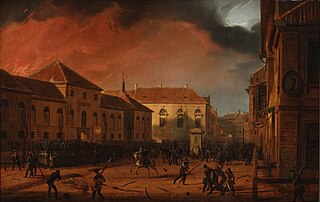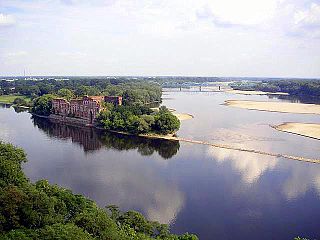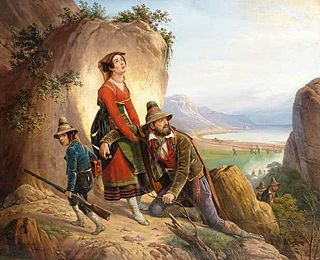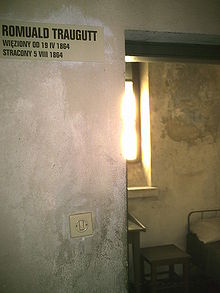
The November Uprising (1830–31), also known as the Polish–Russian War 1830–31 or the Cadet Revolution, was an armed rebellion in the heartland of partitioned Poland against the Russian Empire. The uprising began on 29 November 1830 in Warsaw when young Polish officers from the military academy of the Army of Congress Poland revolted, led by Lieutenant Piotr Wysocki. Large segments of the peoples of Lithuania, Belarus, and Right-bank Ukraine soon joined the uprising. Although the insurgents achieved local successes, a numerically superior Imperial Russian Army under Ivan Paskevich eventually crushed the uprising. The Russian Emperor Nicholas I issued the Organic Statute in 1832, according to which, henceforth Russian-occupied Poland would lose its autonomy and become an integral part of the Russian Empire. Warsaw became little more than a military garrison, and its university closed.

Góra Kalwaria is a town on the Vistula River in the Masovian Voivodeship, in east-central Poland. It is situated approximately 35 kilometres southeast of Warsaw and has a population of around 12,109. The town has strong religious significance for both Catholic Christians and Hasidic Jews of the Ger dynasty.

Count Hans Moritz von Hauke was a Polish general and professional soldier of German extraction. He was a member of the Hauke-Bosak family.

Marshal Edward Śmigły-Rydz also called Edward Rydz-Śmigły, was a Polish politician, statesman, Marshal of Poland and Commander-in-Chief of Poland's armed forces, as well as a painter and poet.

Modlin Fortress is one of the largest 19th-century fortresses in Poland. It is located in the town of Nowy Dwór Mazowiecki in district Modlin on the Narew river, approximately 50 kilometers north of Warsaw. It was originally constructed by the French from 1806 to 1812.

Warsaw Fortress was a system of fortifications built in Warsaw, Poland during the 19th century when the city was part of the Russian Empire. The fortress belonged to a chain of fortresses built in Congress Poland and the region adjacent to it during this period. It was built in stages, with the first part, known as Warsaw Citadel, built the years 1832-1834, in the immediate aftermath of the November Uprising of 1830. This initial fortification was then continually improved by the addition of further forts in its vicinity, with the work finally completed in 1874. In 1879 the government of the Russian Empire decided to carry out a major expansion of the fortress, which would incorporate a system of large forts surrounding the whole city. 20 forts forming this new system were constructed between 1883 and 1890. There were plans to combine the Warsaw fortress with the nearby Modlin Fortress by building a chain of connecting forts, but this work was carried out only partially. The rapid progress in the power of siege artillery required the forts to be continually strengthened. In the final period of its existence the fortress consisted of 29 forts and major works, including the older forts of the original Citadel, which were reinforced by numerous smaller fieldworks.

The Battle of Olszynka Grochowska, or the battle of Grochów, was fought on 25 February 1831 in the woods near Grochów, on the eastern outskirts of Warsaw. The Polish army, commanded by Józef Chłopicki, succeeded in preventing its Russian counterpart, under Hans Karl von Diebitsch, from crushing the uprising. However, the battle has also been described as an inconclusive bloodbath.

Dęblin is a town at the confluence of Vistula and Wieprz rivers, in Lublin Voivodeship, Poland. Dęblin is the part of the agglomeration with adjacent towns of Ryki and Puławy, which altogether has over 100 000 inhabitants. The population of the town itself is 15,505. Dęblin is part of the historic region of Lesser Poland. Since 1927 it has been the home of the chief Polish Air Force Academy, and as such Dęblin is one of the most important places associated with aviation in Poland. The town is also a key railroad junction, located along the major Berlin – Warsaw line, with two additional connections stemming from Dęblin – one westwards to Radom, and another one northeast to Łuków.

Walery Jan Sławek was a Polish politician, freemason, military officer and activist, who in the early 1930s served three times as Prime Minister of Poland. He was one of the closest aides of Polish leader, Józef Piłsudski.

The Western Russian fortresses are a system of fortifications built by the Russian Empire in Eastern Europe in the early 19th century. The fortifications were constructed in three chains at strategic locations along Russia's western border, primarily to combat the threat of Prussia and Austria-Hungary, and to establish Russian rule in new western territories. By the late 19th century the fortifications were obsolete and the system became defunct by the collapse of the Russian Empire in 1917.

Juliusz Karol Wilhelm Józef Rómmel was a Polish military commander, a general of the Polish Armed Forces.

There were many resistance movements in partitioned Poland between 1795 and 1918. Although some of the szlachta was reconciled to the end of the Polish–Lithuanian Commonwealth in 1795, the possibility of Polish independence was kept alive by events within and without Poland throughout the 19th century. Poland's location on the North European Plain became especially significant in a period when its neighbours, the Kingdom of Prussia and Russia were intensely involved in European rivalries and alliances and modern nation states took form over the entire continent.

Count Tadeusz Jordan-Rozwadowski was a Polish military commander, diplomat, and politician, a general of the Austro-Hungarian Army and then the Polish Army.

Sulejówek is a town in Poland, about 18 km east of Warsaw city centre and part of its metropolitan area. It is located in Masovian Voivodeship, in Mińsk County. Its population numbers 19323 (2011).

The War Order of Virtuti Militari is Poland's highest military decoration for heroism and courage in the face of the enemy at war. It was created in 1792 by Polish King Stanislaus II Augustus and is the oldest military decoration in the world still in use.

Apollo Korzeniowski was a Polish poet, playwright, translator, clandestine political activist, and father of Polish-English novelist Joseph Conrad.

Fort Winiary was part of Festung Posen, a system of defensive fortifications around the Polish city of Poznań.

Izaak Kramsztyk (1814–1889) was a Reform Jewish rabbi, preacher, lawyer and writer. He is credited as the first rabbinic teacher of Talmud in Polish. He started a dynasty of Warsaw's benefactors, scientists and writers, which included his sons Zygmunt, Julian, Feliks, Stanisław and his grandson Roman, a renowned painter.

The Battle of Radzymin took place during the Polish–Soviet War (1919–21). The battle occurred near the town of Radzymin, some 20 kilometres (12 mi) north-east of Warsaw, between August 13 and 16, 1920. Along with the Battle of Ossów and the Polish counteroffensive from the Wieprz River area, this engagement was a key part of what later became known as the Battle of Warsaw. It also proved to be one of the bloodiest and most intense battles of the Polish–Soviet War.

The Prince Józef Poniatowski Monument in Warsaw is a monument currently located at 46/48 Krakowskie Przedmieście in the courtyard of the Presidential Palace. Created by Rome-based Danish-Icelandic sculptor Bertel Thorvaldsen in 1829, it depicts Józef Poniatowski (1763–1813) riding and horse and dressed as Roman general.

























